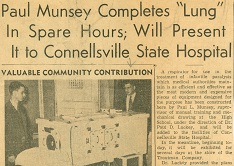

Uniontown's government is composed of a mayor and a five-member city council. Source: NWS Pittsburgh - NOWData / XMACIS Ĭlimate data for Uniontown, Pennsylvania (1981–2010 Extremes 1974–present) Conn House, and Adam Clarke Nutt Mansion are listed on the National Register of Historic Places. The Uniontown Downtown Historic District, Gallatin School, John S.
#David reiss connellsville pa mac
Big Mac Museum Photos According to a McDonald's spokesperson, the decision was based on logistics and access, but Uniontown residents complained in an article that was published in The Herald-Standard. In 2007, the Big Mac Museum was opened in North Huntingdon Township in Westmoreland County, to the disappointment of some Uniontown residents. In 1967, Uniontown was the birthplace of the McDonald's Big Mac sandwich. The USS Uniontown (PF-65), a Tacoma-class frigate, was named for the city by the United States Navy on August 16, 1944, the only ship to be so named. This decline continued into the 21st century, and the population is about half its peak of 1940. It was a mile and a quarter raceway.Īs with most of Western Pennsylvania, Uniontown's economy waned during the region's deindustrialization of the late 20th century, when the steel industry restructured and many jobs went elsewhere, including offshore. "Coal barons" and Carl Laemmle, the president of Universal Films, sponsored the famous Uniontown Speedway board track from 1916 to 1922. During the Coal Boom of the early part of the 20th century, Uniontown was home to at least 13 millionaires, the most (per capita) of any city in the United States. The mill was the town's top industry at that time. The Columbia Rolling Mill, an iron and steel works, was located in Uniontown from 1887 to 1895. Fifteen guards armed with carbines and machine guns held off an attack by 1,500 strikers, killing five and wounding eight. Uniontown was the site of violent clashes between striking coal miners and guards at the local coke works during the bituminous coal miners' strike of 1894. In the late nineteenth century, the town grew based on the development of coal mines and the steel industry.

Residents helped slaves escaping from the South to freedom. Uniontown's role in the Underground Railroad in the antebellum years is commemorated by a marker on the corner of East Main Street and Baker Alley. 10 miles (16 km) southeast of Uniontown is Fort Necessity, built by George Washington during the French and Indian War (part of the international Seven Years' War) as well as the site of the Battle of Jumonville Glen, where the North American branch of the war began. The National Road, also known as the Cumberland Road, was routed through Uniontown in the early 19th century, and the town grew along with the road (now US 40). This was, coincidentally, the same date the United States Declaration of Independence was adopted. Uniontown was founded by Henry Beeson on July 4, 1776.


 0 kommentar(er)
0 kommentar(er)
